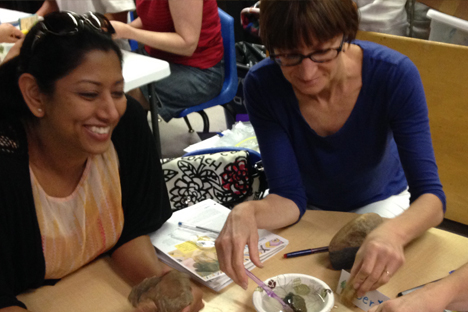Session 4
Session at a Glance
| Topic | Description | Estimated Time (In Minutes) |
|---|---|---|
| Arrival Activity | Students use magnifying lenses to observe common objects such as their own fingerprints, jewelry, pencils, print, and other readily available items. | 10 |
| Welcome, Announcements, and Agenda | Give a general overview of the session and any relevant announcements, and provide time for sharing. | 10 |
| Discussion: Constructivism | Use the story, Fish is Fish by Lio Lionni to engage students in a discussion on constructivism and the teacher’s role in implementing a constructivist model of science education. | 20 |
| Science Focus: Exploring Rocks | Students participate in the exemplar activity: Exploring Rocks. They brainstorm ways to further investigate rocks with young children and discuss the value of free exploration. | 40 |
| Math Focus: Sorting Rocks | Students sort rocks by different attributes. They watch and discuss an Erikson video of a child sorting rocks. | 40 |
| Discussion: The Role of the Environment as Teacher / The Classroom Science Area | Students explore the idea of the environment as the third teacher. Students engage in a "Thought Swap” to exchange ideas about creating a high-interest science area. | 20 |
| Looking Ahead to Next Session | Discuss the homework and reading assignment to be completed before next session, and address the materials that the students will be responsible for bringing. | 10 |
Instructor Guide
- Session 4_Instructor Guide (PDF, 4.3MB)
- Session 4_PowerPoint (PPTX, 24MB)
- Session 4_Exemplar_Exploding Rocks (PDF, 307KB)
- Reader_Session 4_Creating a Science Exploration Area handout (PDF, 58KB)
- Reader_Session 4_Investigating Rocks and Sand article (PDF, 1.6MB)
- Reader_Session 4_The Value of Free Exploration (PDF, 63KB)
- Reader_Session 4_Timely Questions book excerpt (PDF, 526KB)
Student Learning Goals
- Understand the application of constructivist learning in early childhood settings.
- Apply principles of sorting and classifying by different attributes to rocks.
- Identify components of an engaging, high-interest science area.
